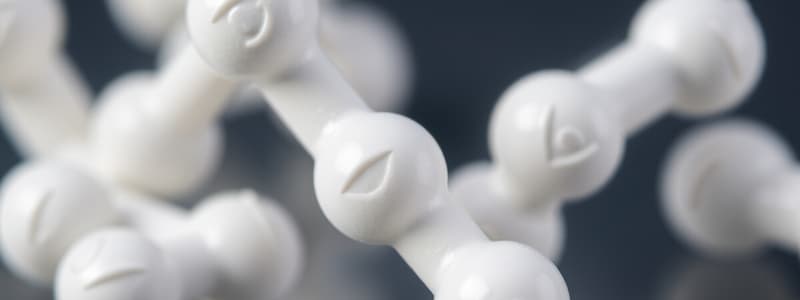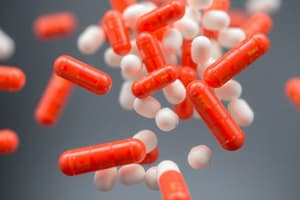Podcast
Questions and Answers
What is the primary mechanism by which anti-HSV drugs inhibit viral replication?
What is the primary mechanism by which anti-HSV drugs inhibit viral replication?
- Competing with nucleotides on the DNA polymerase substrate site (correct)
- Inhibition of viral protein synthesis
- Blocking viral entry into the host cell
- Interference with host cell RNA polymerase
Which of the following is not a requirement for the activation of anti-HSV drugs?
Which of the following is not a requirement for the activation of anti-HSV drugs?
- Presence of specific host cell enzymes (correct)
- Conversion into nucleoside triphosphates
- Phosphorylation by viral enzymes
- Analogues of deoxyribonucleosidetriphosphates
Which condition requires incision and drainage as a primary treatment?
Which condition requires incision and drainage as a primary treatment?
- Redness/heat
- Abscess (correct)
- Oedema
- Draining sinus tract
What is a common characteristic of drugs like Acyclovir and Valacyclovir?
What is a common characteristic of drugs like Acyclovir and Valacyclovir?
Which of the following statements about purulence is true?
Which of the following statements about purulence is true?
What is the primary mechanism by which AmpB induces cell death in fungal cells?
What is the primary mechanism by which AmpB induces cell death in fungal cells?
Which of the following is a significant adverse effect associated with Amphotericin B?
Which of the following is a significant adverse effect associated with Amphotericin B?
Why must Amphotericin B be formulated with artificial lipids for administration?
Why must Amphotericin B be formulated with artificial lipids for administration?
What type of reaction can occur shortly after the intravenous administration of Amphotericin B?
What type of reaction can occur shortly after the intravenous administration of Amphotericin B?
Which of the following statements about Griseofulvin is true?
Which of the following statements about Griseofulvin is true?
What is the primary mechanism of action of azole antifungals?
What is the primary mechanism of action of azole antifungals?
Which azole has the greatest potential to inhibit the CYP450 3A4 isoenzyme?
Which azole has the greatest potential to inhibit the CYP450 3A4 isoenzyme?
Which of the following drugs falls under the echinocandin class?
Which of the following drugs falls under the echinocandin class?
What is a common side effect of echinocandins?
What is a common side effect of echinocandins?
Why should azole antifungals be avoided in pregnancy?
Why should azole antifungals be avoided in pregnancy?
What is the mechanism of action of clindamycin?
What is the mechanism of action of clindamycin?
Which of the following is a significant side effect associated with clindamycin use?
Which of the following is a significant side effect associated with clindamycin use?
What type of bacteria is clindamycin effective against?
What type of bacteria is clindamycin effective against?
Which of the following antibiotics are aminoglycosides?
Which of the following antibiotics are aminoglycosides?
What is a primary characteristic of aminoglycosides in terms of their killing action?
What is a primary characteristic of aminoglycosides in terms of their killing action?
What is a consequence of aminoglycosides’ poor tissue penetration?
What is a consequence of aminoglycosides’ poor tissue penetration?
Why is dosage adjustment necessary in renal failure for aminoglycosides?
Why is dosage adjustment necessary in renal failure for aminoglycosides?
Which of the following statements about clindamycin resistance is true?
Which of the following statements about clindamycin resistance is true?
What is the preferred route of administration for drugs that can cause a histamine-like reaction when infused rapidly?
What is the preferred route of administration for drugs that can cause a histamine-like reaction when infused rapidly?
Which medication is specifically indicated for patients with invasive candidiasis?
Which medication is specifically indicated for patients with invasive candidiasis?
In cases of mild oropharyngeal candidiasis, which treatment is preferred?
In cases of mild oropharyngeal candidiasis, which treatment is preferred?
What should be done for a patient with severe oropharyngeal candidiasis?
What should be done for a patient with severe oropharyngeal candidiasis?
Why are oral azoles contraindicated during the first trimester of pregnancy?
Why are oral azoles contraindicated during the first trimester of pregnancy?
When would oral fluconazole be an appropriate option for treating oropharyngeal candidiasis?
When would oral fluconazole be an appropriate option for treating oropharyngeal candidiasis?
Which medication options are considered effective for initial therapy in oropharyngeal candidiasis?
Which medication options are considered effective for initial therapy in oropharyngeal candidiasis?
Which of the following is NOT a characteristic of fluconazole as a treatment for severe disease?
Which of the following is NOT a characteristic of fluconazole as a treatment for severe disease?
Study Notes
Lincosamides - Clindamycin
- Inhibits bacterial protein synthesis by binding to the 50S ribosomal subunit.
- Exhibits bacteriostatic activity against Gram-positive aerobic and anaerobic bacteria.
- Resistance mechanisms include intrinsic resistance in Gram-negative bacteria and cross-resistance with macrolides.
- Pharmacokinetics: Distributed widely in tissues, including bones and abscesses, but poorly penetrates the central nervous system (CNS).
- Side effects include nausea, diarrhea, rash, contact dermatitis, impaired liver function, and neutropenia.
- C. difficile can cause antibiotic-associated colitis, necessitating treatment with metronidazole or vancomycin.
Aminoglycosides
- Bactericidal antibiotics affecting the 30S ribosomal subunit.
- Key agents: Streptomycin, neomycin, kanamycin, amikacin, gentamicin, tobramycin, sisomicin, netlicin.
- Mechanism of action involves inhibiting protein synthesis via interference with ribosomal function.
- Demonstrates concentration-dependent killing with significant post-antibiotic effects; more effective with single large doses versus multiple smaller doses.
- Pharmacokinetics: High concentration in renal cortex; poor tissue penetration; primarily excreted by the kidneys, needing dosage adjustment in renal failure.
Antivirals - Mechanism of Action for HSV
- Primarily inhibit DNA polymerase through two mechanisms:
- A: Compete with nucleotides on the substrate site—nucleoside analogues (e.g., acyclovir, valacyclovir).
- B: Require viral enzymes for phosphorylation to activate, preventing viral DNA synthesis selectively.
- Other drug actions include disruption of fungal RNA/DNA synthesis via metabolites and inhibition of mitotic cell division (e.g., griseofulvin).
- Amphotericin B binds to ergosterol in fungal cell membranes, leading to cell death, either fungicidal or fungistatic depending on concentration and organism.
Amphotericin B
- Administered via slow intravenous infusion due to low water solubility; requires lipid formulation to reduce toxicity.
- Known for a low therapeutic index with side effects including fever, chills, headaches, vomiting, and renal impairment.
- Can cause renal tubular acidosis and requires potassium supplementation due to magnesium wasting.
Azoles
- Work by inhibiting the fungal cytochrome P450 enzyme (14-α demethylase), disrupting ergosterol production and affecting fungal membrane structure.
- Contraindicated in pregnancy due to teratogenic effects; should avoid in the first trimester.
- All azoles can cause QT prolongation; some notable ones include ketoconazole, itraconazole, voriconazole, and fluconazole.
Echinocandins
- Agents: Caspofungin, micafungin, anidulafungin, which inhibit β(1,3)-D-glucan synthesis in fungal cell walls.
- Effective against Aspergillus and most resistant Candida species.
- Common side effects include fever, rash, nausea, and phlebitis; avoid rapid infusion to prevent histamine-like reactions.
Oropharyngeal Candidiasis - Initial Therapy
- Mild cases benefit from topical therapies such as clotrimazole troches or miconazole buccal tablets, which are more effective than nystatin.
- Fluconazole is favored for severe cases due to ease of administration and favorable side effect profile.
- Pregnant women should use topical therapies (e.g., clotrimazole, miconazole), avoiding oral azoles in the first trimester due to teratogenicity risks.
Studying That Suits You
Use AI to generate personalized quizzes and flashcards to suit your learning preferences.
Related Documents
Description
This quiz covers the mechanism of action of Clindamycin, a type of lincosamide, and its effects on bacterial protein synthesis. It includes information on its spectrum of activity against gram-positive bacteria, resistance mechanisms, and pharmacokinetics. Test your knowledge on this important antibiotic and its clinical implications.




